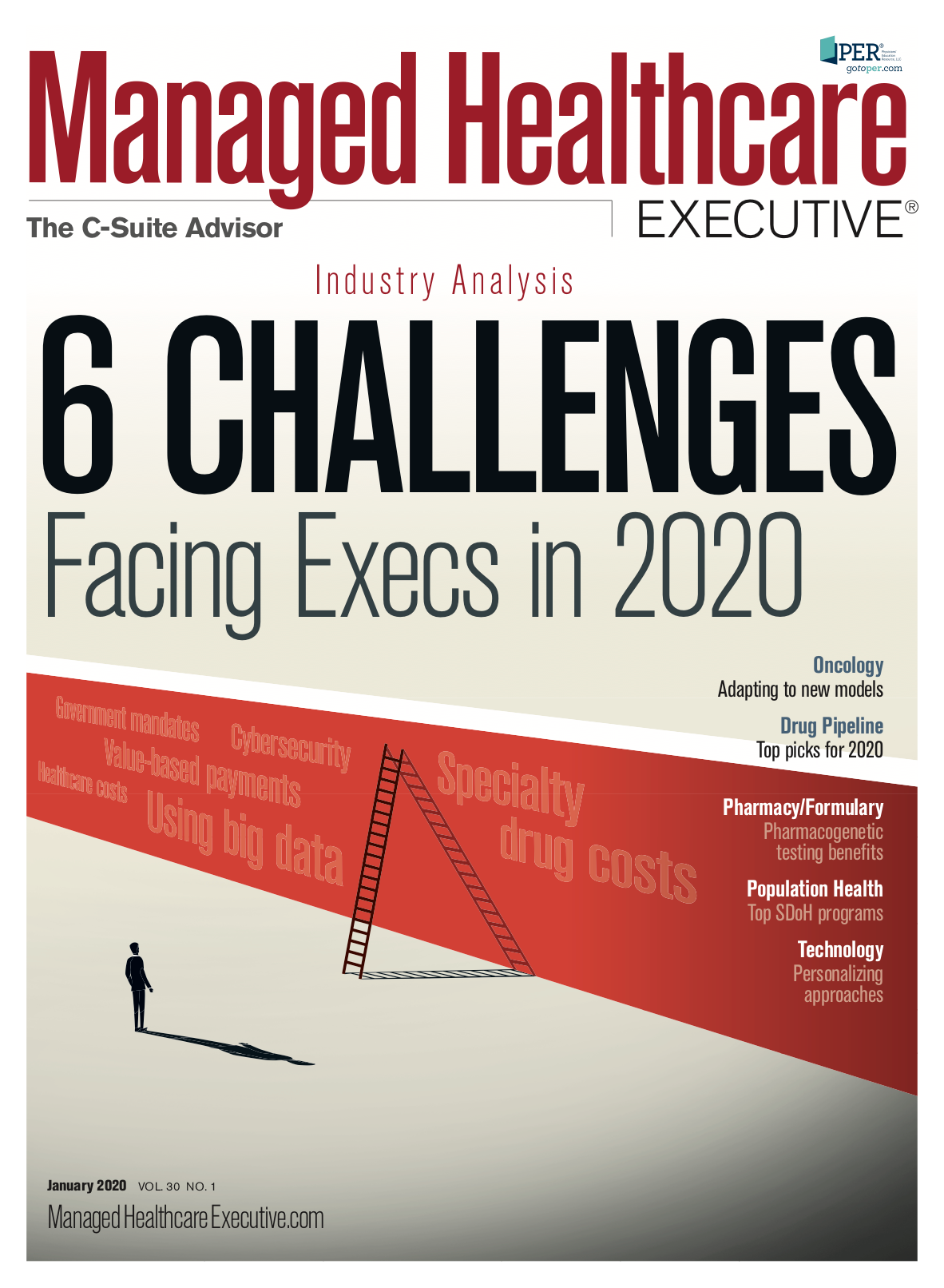Top 6 Challenges Healthcare Executives Will Face in 2020
Here are healthcare leaders’ top challenges, as well as coping strategies

Kim Bell

Ashraf Shehata

Tara Bradley

Kelli Fleming

Layna Rush

Matt Gagalis

As a new decade begins, healthcare executives will continue to grapple with challenges of the past as well as new issues that emerge. We asked healthcare leaders to cite their top challenges, as well as coping strategies. It was no surprise, particularly with 2020 being a presidential election year, that dealing with an ever-changing landscape of government regulations topped the list. Here’s a closer look at what they said.
Challenge 1: Complying with new government requirements and mandates
Efforts to repeal the Affordable Care Act seem unlikely in the near term. “Nonetheless, healthcare executives always need to proactively stay on top of regulatory developments so they can position their organizations for the opportunities and challenges that may emerge as a result of changes,” says Kim Bell, senior vice president of health services, NFP, an insurance broker and consulting firm in Austin, Texas.
New mandates, both at the state and federal level, add a layer of complexity to running a business. Healthcare remains one of the most highly regulated industries, since approximately half of all of the industry’s spending comes from government sources (e.g., Medicare, Medicaid, Veterans Affairs, and government employee benefits), says Ashraf Shehata, MBA, MHA, national sector leader for healthcare and life sciences, KPMG LLP, an audit, tax, and advisory firm. “They update their rules with great regularity, so it’s important for healthcare organizations to stay current with the latest regulatory developments,” he says.
In particular, CMS’ push toward price transparency has resulted in many questions from payers and providers. “In 2020, we will see the price transparency mandate continue to play out and likely encounter more uncertainties,” says Tara Bradley, chief operating officer, Vitalware, a mid-cycle revenue software as a service solutions provider, in Yakima, Washington. “Specifically, hospitals have been tasked with the complicated duty of posting their chargemasters online. This process is not only difficult, but the information presented in a chargemaster is confusing and does little to further transparency or education.”
Related: Managed Care State of the Industry 2019
In addition, HHS recently released proposed changes to the antikickback statute and Stark Law. “Although we don’t know which portions of the proposed changes will be implemented in final rule-making, there will be changes that will more than likely come in 2020,” says Kelli Carpenter Fleming, Esq., a partner in the healthcare group at Burr & Forman LLP, a law firm located in Birmingham, Alabama.
Dealing with this challenge
Regarding the Stark Law changes, healthcare providers should review the proposed changes and start thinking about what relationships, if any, will be impacted by them. “Getting up to speed on the changes and ensuring that existing relationships are compliant should be a priority in 2020,” Fleming says.
Bradley’s advice for dealing with the uncertainty of CMS’ mandates is to always stay one step ahead. “Instead of waiting for CMS directives, hospitals should feel empowered to initiate processes and programs to educate patients and make pricing less complicated,” Bradley says. “Hospitals will need to improve their ability to understand their own pricing data, how they can operationalize that insight, and then continuously measure the effects of their actions and adjust accordingly.”
The push for pricing transparency will require hospitals to review pricing quarterly or even monthly. Hospitals can also hire billing specialists, who can better handle the influx of customer questions related to pricing and serve as middlemen between the hospital and insurance company to help patients better understand their out-of-pocket costs, Bradley says.
To comply with government regulations in general, a well-resourced, internal audit function can address many issues. “If an organization is well funded and has the resources to investigate and address potential risks, it can protect relationships with stakeholders, including patients, regulators, and contractual counterparties,” Shehata says.
Challenge 2: Shifting to value-based payment models
The shift from fee-for-service reimbursement to value-based payment models will continue in 2020, including the trend for healthcare providers and third-party vendors operating in the healthcare space to assume some of the financial risk along with the health insurer. “While these relationships are appealing, there is the risk that they will be unprofitable if not structured properly,” says Layna Cook Rush, JD, shareholder, Baker, Donelson, Bearman, Caldwell & Berkowitz, PC, a law firm with offices in the Southeastern United States and Washington, D.C.
Along these lines, Matt Gagalis, head of payer market development, CarePort Health, a care coordination software company, says that as value-based care continues to take hold and the number of stakeholders responsible for improving patient outcomes increases, the fragmentation within the healthcare industry has become increasingly apparent. There will be a critical need for alignment and coordination across the continuum.
Dealing with this challenge
“With multiple stakeholders trying to manage a patient’s care, there is immense opportunity for enhanced stakeholder interoperability to reduce disparate systems of care and align a network on one centralized platform,” Gagalis says. To share existing data, synchronize workflows and streamline processes between various stakeholders, payers, and providers should use care coordination technology that collects, analyzes, and shares information across the continuum.
Because payments in these models are contingent, at least in part, on the provider meeting certain metrics, it is imperative that those metrics are within the provider’s control, Cook Rush says. Also, it’s important from both parties’ perspectives that the metrics and data being measured are an actual assessment of improved health that will result in cost savings. “When entering into an outcome- or value-based contract, healthcare executives need to analyze historical data to ensure that the metrics are an attainable and appropriate measurement of health improvement,” she says.
Furthermore, as parties enter into these types of agreements and providers take on additional responsibilities and financial risk, it is important to assess whether the relationship will be subject to regulation under state insurance or managed care regulations, Cook Rush says. Because of the shift in responsibilities, the provider may be required to register or seek licensure as a regulated entity. For instance, the California Department of Managed Health Care has oversight of risk-bearing organizations, which can encompass physician-owned entities that bear risk. A review of state laws and regulations should be conducted when structuring the relationship.
Challenge 3: Using big data
To gain meaningful data insights, payers must adopt technology that makes the data actionable and contextual-using it to inform clinical decision-making and improve care management, Gagalis says. Health plans should seek solutions that not only provide data from disparate sources, but that can also display data in a way that is meaningful and actionable.
For example, the recently enacted California Consumer Privacy Act requires businesses to inform consumers about the personal information they collect and how it will be used; consumers’ personal information cannot be used for any purpose that wasn’t disclosed at collection, Cook Rush says.
Dealing with this challenge
Businesses need to be cognizant of state and federal privacy laws that may limit how big data can be used. Monitoring data’s security is also key. The information may constitute protected health information under Health Insurance Portability and Accountability Act or personal information under state privacy and security laws. “Companies may need to employ protections such as firewalls, encryption, and other security measures to guard against unauthorized access to the data,” Cook Rush says. And, if data is hacked or stolen, there is the potential that individuals may require notice of the incident.
Challenge 4: Implementing cybersecurity measures
Healthcare entities are continuing to see a rise in the number of cyberattacks. Attackers are getting smarter and more persistent. Employees are getting more comfortable working with electronic information (which sometimes makes them more relaxed and susceptible to oversights). Records maintained within the healthcare industry are valuable due to the vast amount of information contained therein, and providers typically maintain several electronic systems containing patient information (e.g., electronic medical records, billing, practice management, email), all of which are susceptible to attack, Fleming says.
Dealing with this challenge
Since many recent threats to security arise from phishing scams and ransomware attacks, it is imperative that companies not only have policies and procedures in place, but that they also create a culture of “cyber hygiene.” Employees must be trained on, and continually reminded of, how to detect and respond to a potential phishing email, Cook Rush says. And, sanctions for continued violators should be implemented. Given the prevalence of ransomware attacks, companies should routinely back up critical data and have an incident response plan that addresses swift access to back-up data to ensure that operations and services can continue with minimal interruption. Incident response plans should be reviewed and tested routinely.
Furthermore, entities should implement plans for stopping an attack and mitigating harm, as well as notifying those who have been affected, Fleming says. Regarding notification, providers must not only be familiar with the laws in their state but also the states in which their patients reside. This is because a number of state data privacy and security laws are attempting to impose obligations on entities located outside of the state that maintain information on residents living within the state.
Challenge 5: Rising cost of healthcare
According to Kaiser Family Foundation research, the annual cost of a family health insurance plan has now surpassed $20,000. Some of the primary reasons include escalating drug prices, particularly in specialty drugs; high-cost therapies coming to market; and industry consolidation, Bell says.
Employers have traditionally shifted higher costs to employees. But as costs continue to rise, employers are discovering a number of ways to mitigate the impact of rising costs, such as narrowing networks, promoting medical tourism through centers of excellence, creating reference-based pricing structures, and offering bundled pricing, direct primary care access, and expert opinions, Bell says.
Dealing with this challenge
Payers and providers should continue their efforts to be a part of the solution, working to partner with employer coalitions and work groups to help solve the problems that contribute to the high cost of healthcare. In addition, they should increase their focus on innovative solutions to the problem. “Consider what can be done differently to enhance efficiency and effectiveness, both in terms of improving what is working and fixing what’s not,” Bell says.
Challenge 6: Rising cost of specialty drugs
Plan sponsors recognize the value that specialty medications have in treating complex and rare diseases; the trend is up by 9.4%. But specialty drugs cost 50 times more than traditional drugs. In most cases, price increases directly affect Americans who, in some cases, can no longer afford medications they so desperately need, Bell says.
Dealing with this challenge
In May 2018, the Trump administration issued a strategy blueprint, “American Patients First,” designed to tackle U.S. drug pricing and healthcare costs. According to Bell, a few of the key components related to reducing drug pricing are:
- Promoting the use of biosimilars and reducing utilization barriers;
- Preventing branded drug manufacturers from gaming FDA risk management strategies and 180-day generic launch rules to forestall generic competition;
- Requiring drug rebates negotiated by pharmacy benefit managers to be passed directly to patients;
- Requiring drug companies to disclose list prices for their drugs in television ads, just as they do for side effects and other drug risks.
While many components have not yet been addressed, areas such as providing avenues to bring more generics to market have.
On October 16, 2019, HHS Secretary Alex Azar announced that in fiscal year 2019, the FDA approved a total of 1,171 generic drugs, an all-time record, following a record 971 approvals in fiscal year 2018 and a record 937 approvals in fiscal year 2017.
In addition, Azar said that legislation, such as HR-3’s Title I of The Lower Drug Cost Act of 2019, is proposing that HHS be allowed to negotiate drug prices based on international standards. “We have also seen significant moves toward bringing more transparency to consumers, through removal of gag orders on pharmacists not to mention lower cost drugs and requirements that drug ads disclose the cost of the drug being advertised,” Azar said.
Diligently monitoring and understanding these changes is critical, as is making sure they are aligned with the best industry solutions in the space, Bell says. Also consider their effect on programs such as value-based care and established clinical pathways.
Karen Appold is a medical writer in Lehigh Valley, Pennsylvania.

In the Scope of Virtual Health and the Future of “Website” Manner, Per Ateev Mehrotra
August 10th 2023Briana Contreras, an editor of Managed Healthcare Executive, had the pleasure of catching up with MHE Editorial Advisory Board Member, Ateev Mehrotra, MD, MPH, who is a professor of healthcare policy at Harvard Medical School and an Associate Professor of Medicine and Hospitalist at Beth Israel Deaconess Medical Center.
Listen
Extending the Capabilities of the EHR Through Automation
August 2nd 2023Welcome back to another episode of "Tuning In to the C-Suite," where Briana Contreras, an editor of Managed Healthcare Executive, had the pleasure of chatting with Cindy Gaines, chief clinical transformation officer at Lumeon.
Listen